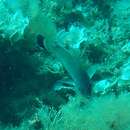en
names in breadcrumbs


Centrolabrus melanocercus, the black-tailed wrasse, is a species of marine ray-finned fish from the wrasse family Labridae which is found in the Mediterranean Sea and the Sea of Marmara.[2] This species was formally described in 1810 as Lutjanus melanocercus by Antoine Risso with the type locality given as Saint Hospice near Villefranche-sur-Mer on the Mediterranean coast of France.[3] This species was regarded as a member of the genus Symphodus but meristic and behavioural data placed it closer to the rock cook than the sexually dimorphic paternal nesting fishes in Symphodus.[4] This species prefers areas with rocks or eelgrass at depths from 1 to 25 m (3.3 to 82.0 ft). It can reach 14 cm (5.5 in) in total length, though most do not exceed 11 cm (4.3 in).[2]
Centrolabrus melanocercus, the black-tailed wrasse, is a species of marine ray-finned fish from the wrasse family Labridae which is found in the Mediterranean Sea and the Sea of Marmara. This species was formally described in 1810 as Lutjanus melanocercus by Antoine Risso with the type locality given as Saint Hospice near Villefranche-sur-Mer on the Mediterranean coast of France. This species was regarded as a member of the genus Symphodus but meristic and behavioural data placed it closer to the rock cook than the sexually dimorphic paternal nesting fishes in Symphodus. This species prefers areas with rocks or eelgrass at depths from 1 to 25 m (3.3 to 82.0 ft). It can reach 14 cm (5.5 in) in total length, though most do not exceed 11 cm (4.3 in).